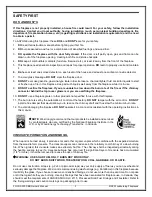
FOCUS 320 SBR Owner's Manual
8
RSF Woodburning Fireplaces
OPERATION
AIR CONTROLS
Combustion Air Control
The bi-metallic coil is a unique feature built into your fireplace. It serves as a fully automatic combustion air control.
As the fireplace heats up, it will activate the bi-metallic coil. This will automatically begin to shut down the air entering
the firebox, slowing the combustion process. This will save you wood, reduce emissions, improve efficiency, and
prevent the fireplace from overheating and causing potential damage to the firebox.
Outside Air Control
The FOCUS 320 SBR is designed to use outside air for combustion.
Because outside air is generally colder and denser it will help to start the fire. In some cases, fresh air will help
compensate for negative pressure problems within the house; however, it will not prevent the fireplace from smoking
in a severely depressurized house.
We recommend always using outside air for combustion, but you may choose to use room air for combustion
instead. You will find a sliding door behind the bottom louver and below the firebox. Push the sliding door towards
the back to select outside air or pull it toward the front to select inside air as the combustion air.
If the fireplace is installed in a mobile home, the outside air MUST be used as combustion air.
IMPROVING EFFICIENCY
The location of your fireplace will affect how efficiently it heats the home. Your fireplace should be located in part of
the house you want to be the warmest. Trying to heat the main floor with a fireplace in the basement will generally
overheat the basement and waste fuel. Certain RSF options offer the ability to move heat from the main floor to the
basement. This allows you to efficiently heat your primary space while also heating the basement as a secondary
space.
The efficiency will also be influenced by the draft in the chimney which will be influenced by various factors (refer
to "Importance of draft" below) and by the amount of wood burning at any point (see "Burn Time vs Heat Output"
below). The efficiency will also be influenced by the quality of the wood (refer to "Fuel" below).
All of these factors must be taken into account and optimize so you can recover the maximum heat from your
fireplace.
IMPORTANCE OF DRAFT
Draft is the natural force which pulls air from the fireplace up the chimney. The strength of draft in your chimney
depends on a variety of factors, including chimney height, nearby obstructions, altitude, etc.
Excessive draft can result in a hotter fire than intended or reduced burn times as more air is pulled through the
fireplace. It will also result in less heat recovery since the heat will not have as much time to radiate into the room
before being sucked into the chimney.
Weak draft can result in smoke entering the room and difficulty lighting or operating the fireplace. Weak draft is
often incorrectly associated as a blockage in the air intake for the fireplace. Adding chimney height is the most
common solution. See Table 3 for minimum chimney height recommendations.
BURN TIME VS HEAT OUTPUT
The faster your fireplace burns the more heat it will create; however, faster fires result in much more hot air flow up
the chimney which means you are sacrificing efficiency. Fast burning fires (lots of air) go through much more wood
than slow burning fires. Your fireplace burns at a fixed rate depending on the heat inside the firebox. It will burn
quickly during light up and then gradually slow down to offer the best efficiency and emissions reduction.









































